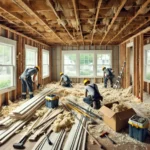In the ever-evolving landscape of urban development, demolition services have become a critical player. They pave the way for urban renewal projects, transforming outdated or damaged buildings into opportunities for growth and innovation. From tearing down entire blocks to make room for public spaces, to addressing safety concerns in structurally compromised buildings, demolition is often the first step towards a city’s vibrant future. However, it’s not just about knocking buildings down. Demolition services ensure the safe removal of hazardous materials before any new construction begins. This is essential in preserving the health and safety of the community during these large-scale projects. Whether it’s due to outdated design, structural damage, or expansion plans, demolition services provide a necessary and valuable service in the process of urban renewal. So, let’s delve deeper into the crucial role they play in shaping our cities.
The Role of Demolition in Urban Renewal Projects
Stepping into the expansive sphere of urban renewal, it’s important to understand the vital role demolition plays. Adaptation, improvements, and transformation pivot around demolition services, serving as the initiating spark for urban enhancement and growth.
Understanding Urban Renewal
Urban Renewal (UR) signifies a systematic approach to revitalizing city regions, presenting numerous initiatives and stakeholders. Hazards arise during the UR process, and they can trigger tension, conflicts, and discord among stakeholders. These are social risks (SRs) impeding not only the smooth running of urban renewal projects, but also pose a challenge to societal stability and harmony. Therefore, to facilitate a successful implementation of sustainable and effective UR projects, it becomes crucial to grasp the emergence and evolution mechanisms of these social risks.
Key Reasons for Demolition in Urban Planning
Inspect any metropolis and find demolition as a common theme in urban planning. But why pull down existing constructions? Essentially, three driving factors inform the adoption of demolition in urban planning.
Structural Damage:
Each building possesses an expiry date. Structures endure stressors like natural disasters, time, and basic wear and tear, moving either towards repair or demolition. In several instances, structural damage masks its presence till visible cracks emerge, often demanding significant resolution. We encourage property owners to consult property evaluation experts and make informed decisions about the future of their buildings under such circumstances.
Outdated Design:
Progression denotes change, and with time, building designs grow obsolete. When renovation costs soar higher than recreating, demolition surfaces as the most feasible option. An outdated design isn’t restricted to appearance alone but encompasses infrastructural elements like load-bearing walls and support beams. Our shared goal in urban renewal is to prioritize modern building codes and standards.
Expansion Plans:
Modernization seeks expansion, and sometimes, it means razing existing buildings to make room for new ones. Expansion plans are opportunities where demolition paves the way for functionality and visual upgrades, significantly boosting property value in the process. In this urban epoch, timely demolitions are pivotal for structural safety and progression alike, outlined in the canvas of urban renewal.
Impacts of Demolition on Urban Communities
In the realm of urban renewal, well-executed demolitions evoke transformative effects. It’s instrumental to consider their economic, environmental, and socio-cultural consequences.
Economic Implications
Demolition might precipitate a ripple of economic ramifications. It paves the way for modern structures paving the way for increased property values. Adequate consideration of monetary factors like structural safety and return on investment are critical, facilitating sustainable urban renewal. Consider for a moment a compromised building posing safety risks, its demolition and subsequent replacement not only improves the aesthetic of the community, but could potentially increase neighborhood value considerably, setting a precedent for enhanced urban economic viability.
Environmental Considerations
Urban redevelopment inevitably stimulates critical environmental discussions. While demolition processes might trigger short-term environmental strain from debris, it’s important to note that they offer opportunities for greener, more sustainable infrastructure. Newly built structures tend to incorporate advanced, environmentally friendly technologies enhancing overall community sustainability and resilience qualities. Rebuilding also means the chance to mould an energy-efficient, environment-conscious community thus reducing long-term carbon footprints.
Social and Cultural Effects
It’d be remiss to ignore the social and cultural impact demolitions might enact. Although destructive in nature, demolition often gives birth to spaces that foster community growth, modernity, and social interactions. However, it’s equally critical to acknowledge that it might displace existing communities causing potential damage to the social fabric. Balancing the preservation of social and cultural identity with the necessity of urban renewal stands as a significant challenge to city planners. For instance, ensuring measures are taken to preserve architectural structures of historical significance fosters a community’s cultural growth while embracing the necessity of change.
Balancing Demolition with Historic Preservation
Embarking on the delicate task of balancing demolition with historic preservation often presents an intricate puzzle in urban renewal projects. Key factors to consider include maintaining cultural heritage whilst implementing modern, cost-effective redevelopment.
Challenges of Preserving Historical Sites
Maintaining historic integrity amidst urban redevelopment poses numerous challenges. Primarily, outdated design elements in older buildings, such as load-bearing walls or support beams, often fail to meet modern safety standards. Additionally, such structures frequently lack contemporary amenities, like energy-efficient windows and insulation, leading to increased utility costs.
Furthermore, expansion possibilities tend to be adversely limited by outdated floorplans necessitating significant renovations, or in severe cases, demolition. For example, adding square footage to your home might require razing due to the restricting old floor plan while simultaneously affording the opportunity to modernize your home’s overall aesthetic.
Success Stories of Integrated Urban Renewal
However, against the backdrop of these challenges, several urban renewal projects have successfully married the preservation of historic charm with modern necessities.
One worth mentioning is the case of the ancient residential area of KuanzaiXiangzi in Chengdu, which preserved the cultural significance while upgrading the city’s image. In this instance, urban development encompassed an integral cultural component, successfully enhancing social cohesion and community wellbeing.
These successful urban renewal projects underline the possibility of acknowledging social identity amidst modern reforms. The process, while complex, can lead to renewed, safe, and efficient structures that breathe new life into historic sites while preserving their rich cultural heritage.
Future Trends in Urban Redevelopment
Moving into the future, urban redevelopment faces new horizons shaped by technological advancements and dynamic policy shifts. These factors play a significant role in influencing the direction and approach of urban renewal practices.
Technological Advancements in Demolition
Technological advancements offer new dimensions to the demolition aspect of urban renewal. Progressive technology provides mechanisms valuing efficiency and precision, vital in demolition projects within dense locations. For instance, a case demonstrated these merits: when a building, standing only 78 meters from the closest structure, needed demolishing, innovative procedures tackled the intricacy. Similarly, another challenging project in Kerala, India saw the implosion of three high-rise buildings, each located within 1.5 km of each other.
Enhancements in technology widens opportunities, enabling experts to tackle complex projects with greater precision, safety, and efficiency. These improvements help reduce potential harm to adjacent structures or the overall environment, reinforcing the paramount safety aspect of any demolition procedure.
Policy Developments Affecting Urban Renewal
Policy advancements equally shape and influence the future of urban renewal projects. Take the Urban Renewal Program adopted under the Housing Act of 1949, Title I, as a foundational model. This Act looked at “clearing slum dwellings” through demolitions – deemed unfit for habitation – replacing them with modern high-rise developments or transport infrastructure. It’s a step towards modernizing cities, with goals not just limited to improving the physical environment but fostering socio-economic revitalization as well.
These policy advancements aim to reform outdated regulations supporting modern urban planning and development needs. They seek to balance historic preservation with economic progress, ensuring the city’s architectural heritage remains undisturbed while stimulating socio-economic growth.
Conclusion
We’ve seen how demolition plays a pivotal role in urban renewal, driving city growth and modernization. It’s clear that balancing economic progress, environmental considerations, and socio-cultural preservation presents a complex challenge. However, examples like the KuanzaiXiangzi area in Chengdu show us that it’s possible to blend historic charm with modern necessities. This balance fosters social cohesion and community well-being, while retaining the cultural heritage that gives our cities their unique identities. Looking forward, we anticipate that technological advancements will continue to revolutionize demolition practices, offering greater efficiency and precision. Additionally, policy shifts like the Urban Renewal Program under the Housing Act of 1949 will continue to shape our urban landscapes, striving to harmonize economic development with historical preservation. In essence, demolition is not just about tearing down the old, but also about paving the way for a vibrant, sustainable urban future. If you have an upcoming project requiring demolition in Philadelphia, New Jersey, Connecticut or Maryland, contact Bella Demolition and Contracting Services to speak about how their services can meet your needs.



